Blog in Polish/blog w języku polskim: http://ontario-nature-polish.blogspot.com/2021/12/w-parkach-bon-echo-i-darlington-w.html
More photos/więcej zdjęć: https://www.flickr.com/photos/jack_1962/albums/72177720295612258/page1
The second summer during the COVID-19 pandemic was somehow similar to the previous one in 2020 and again a lot of Canadians were forced to enjoy vacationing in Ontario, as it was not possible to travel by land to the USA. Thus, I had made a number of park reservations many months in advance. My first reservation in Long Point Provincial Park, where I was planning to go in mid-May, 2021, was cancelled due to the extension of the COVID-related restrictions. It was not very easy to book my favourite campsites for a week, especially over long weekends, yet I think it was still simpler than last year and more campsites were vacant.
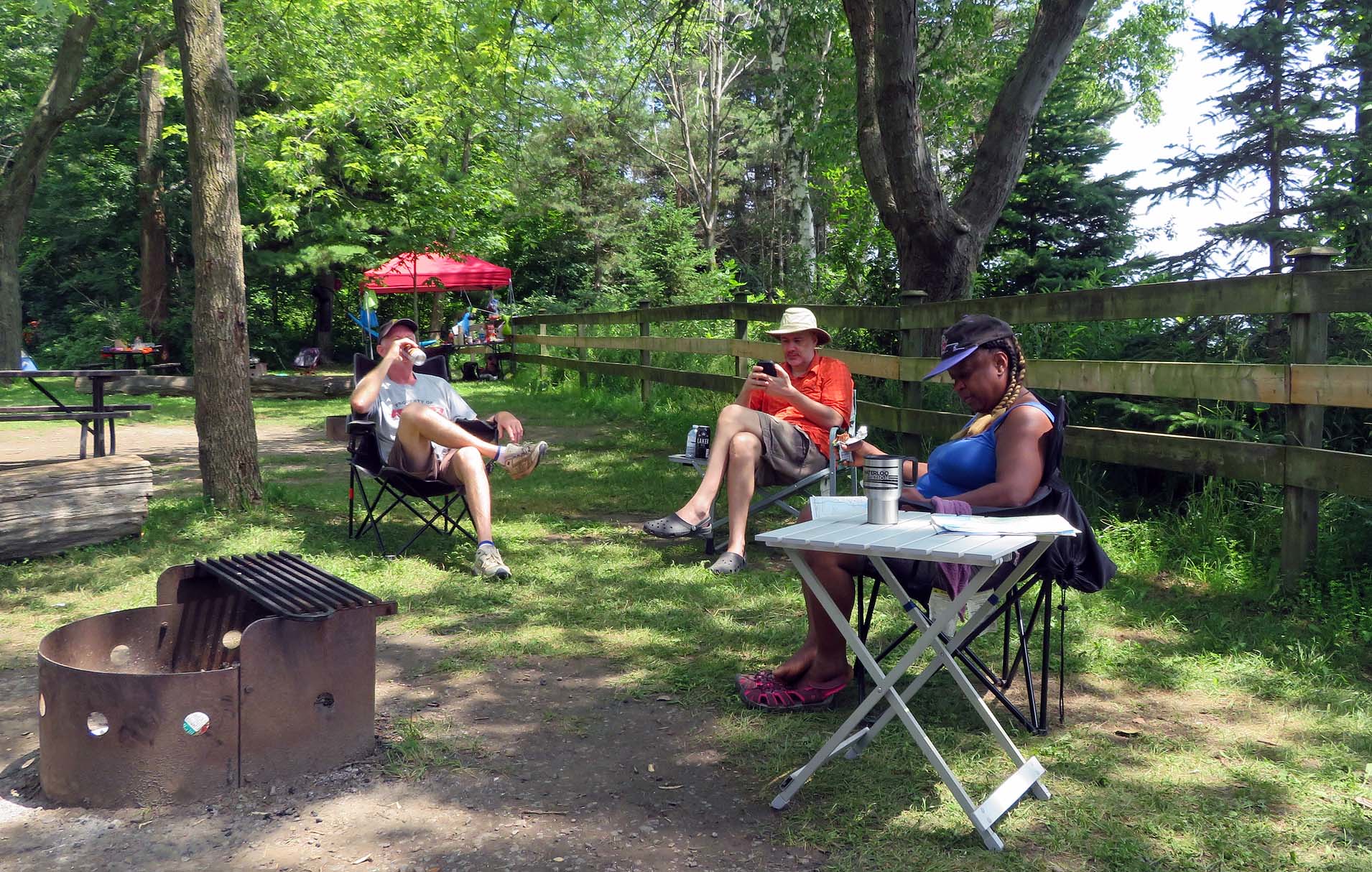 |
| Camping in Darlington Provincial Park on campsite #159, just meters from Lake Ontario |
Darlington Provincial Park
 |
| My new tent, Eureka El Capitan 3 (in Bon Echo Park) |
Eureka El Capitan 3 Tent
The first time I bought a Eureka El Capitan 3 tent in 2006, upon a personal recommendation of Kevin Callan, the legendary canoeist & author (whom I had met in Bon Echo park in 2003), and used it extensively while camping with Meetup groups and during numerous canoeing trips with Catherine. In 2011 Catherine decided to buy her own tent—exactly the same model—and from then on we used hers, yet I still used mine whenever we were not camping or travelling together. However, after 14 years of rather extensive usage my tent was getting a little too old and it was the time to invest in a new one. I had considered purchasing a different model, made by a different company, but after researching similarly priced tents, the El Capitan 3 was, in my opinion, the best one. Its main advantages were two very spacious vestibules (perfect for keeping numerous bags, especially during canoe trips), two separate entrances, totally waterproof fly and a lot of guy points to attach guy ropes to keep it secure in case of strong winds. We used the last feature many times; once we set up the tent on a top of a flat rock; at night the winds reached 75 kilometers per hour, yet the tent withstood such weather and kept us dry and warm. I think that a reliable tent is the most important piece of camping equipment and it makes no sense to buy a cheap one, which is going to leak the first time it rains.
However, even such reputable company as Eureka sometimes turns out a substandard product—unfortunately, Catherine’s El Capitan 3 was one of them. Just after she bought it, I realized that something was weird with the zippers, which did not work as smoothly as the ones in my tent. Besides, we could tell the workmanship was inferior—for example, the stitching in the fly pole pocket unraveled the first time we used the tent. After the camping season was over, I drove to Burlington and dropped the tent off at Eureka’s office to be repaired under the warranty. The following camping season (2012) we noticed that the mesh was separating at certain parts of the door where the puckering occurred. Two or 3 tiny holes appeared which we taped up. Also the strain on the zipper caused it to break up for a 30 cm separation. Catherine was able to sew it shut so the zipper did not continue to unravel. But it did mean that we could not fully open the door though. In 2013 part of the door mesh totally separated and we had to perform an extensive repair which left us unable to fully open the door. On our first back country trip in 2014 in Killarney Provincial Park another segment of the mesh on the door gave way (at least one meter) and suddenly our tent was filled with black flies and mosquitos. Luckily, we brought a Gorilla tape with us and were able to repair the door by patching up the openings. Besides, we had noticed that the fine stitching in the mesh is running / laddering and we knew that if this process continued, soon black flies and then mosquitos would be able to enter out tent. For all intents and purposed, the tent became unusable!
 |
| Killarney Provincial Park, June, 2013. Catherine's El Capitan 3. Unfortunately, it turned out to be a total dud! |
I wrote an email to Eureka Tents in Burlington, Ontario, describing our problems and attaching a bunch of photographs, clearly depicting the issues we described. Lo and behold, the Eureka rep offered us a brand new tent! We drove to Burlington, dropped off the defective one and got a new one! He said that after reading our email, he was sure that indeed, we must have gotten a dud! And most likely he was right: the new tent has been working impeccably since 2014, the one I bought in 2021 so far has been perfect, and my old one, now 15 years old, is still quite usable and does not even leak! In any case, I was impressed with Eureka’s customer service—some companies will do anything to “save” a few bucks, yet they do not realized that in the long run they are going to lose a lot of customers!
 |
| Franklin Island, June, 2015. Finally camping in the new Eureka El Capitan 3! It was perfect! |
It was so good to meet Guy, Robin, Bill and Peggy, sit around the fire (or under the canopy while it was pouring cats and dogs) and just relax! Unlike in the previous year, the shower facilities were open in parks this year. Unfortunately, when I wanted to take a shower in the evening, it was closed. Also, the nearest comfort station was closed and an “out of service” sign was posted. I drove to another comfort station and it was “out of service”, too—and so were the showers. I headed to the washrooms in the park store and they were also shut. Finally park employees told me that it was due to the power outage and I was advised to use the vault toilet located near the group campground. Later that evening several campers were quite frustrated, as they were unable to use washrooms and had no idea where to find a working toilet—which, by the way, was about 1 km away from our camping area—quite a stroll, especially at night!
 |
| Yes, it did rain while we were camping! |
First of all, I think that the park should have been prepared for such probable emergencies as power outages and had a backup system (either emergency generators or more vault toilets); secondly, instead of just attaching “out of service” signs, providing more information and directions to alternative facilities would have been a much better idea. Next morning, when I was leaving and heading to another park, the bathrooms & showers still remained closed and I was unable to take a shower.
I also drove to the nearest city, Bowmanville, to a huge shopping mall at the highway 2 & Bowmanville Avenue (a.k.a. road 57) area. There were numerous stores, including Loblaws, Walmart, Canadian Tire, Shoppers Drug Mart, Dollarama, The Home Depot and many more.
Bon Echo Provincial Park
My next camping trip commenced on July 14, 2021, so I left Darlington Park directly for Bon Echo Provincial Park. It was not easy to book my preferred campsite and I was lucky when I managed to reserve site #495 (N44° 53.672' W77° 15.251'). Before arriving at the park, I read a bunch of TripAdvisor reviews and one, written in 2018, described campsite #495 as “private, with full shade and with so many mosquitoes” that the reviewers “had to move to another site in order not to be eaten alive.” Thus, I brought an extra can of mosquito spray and hoped for the best. Incidentally, the authors of that review turned out to be friends of mine, Lynn and Wayne, with whom I had camped numerous times, including in Bon Echo Park—the world is a small place!
I also made a short video about setting up and taking down my tent-in just one minute!
Indeed, this campsite was very private and shady, and required a walk of 10-15 meters from the car. I hardly ever saw the sun, which was probably a good thing: it was very hot and humid, the weather forecast called for storms, rains and at one point a tornado warning was issued for that area (and a tornado did hit the city of Barrie). Eventually, there was a storm or two and it rained, but it was not long lasting and no damage was done. From this campsite I did not see any other campsites, either. Nevertheless, if I could, I would rather camp on a different site.
 |
| Welcome to Bon Echo Provincial Park! |
Initially I thought that mosquitoes would be a huge problem. Yet I was amazed how few of them were active—I used the bug spray on just a few occasions, mainly to spray the rim of my hat. In fact, during my second stay in Bon Echo neither I nor my friends used the mosquito spray even once, as there were no mosquitos! Afterwards I camped at 3 other parks and NEVER used the spray, not even once! I thought the weather in the summer was perfect for mosquito breeding (hot, humid and relatively frequent rains), but thankfully I was wrong. I asked a few wardens if they knew the reason, but nobody had any answer. All I can say is that I had never experienced such a mosquito-free summer in my over 30+ years of camping. I am wondering if it was because of COVID-19, which also affected mosquitoes?
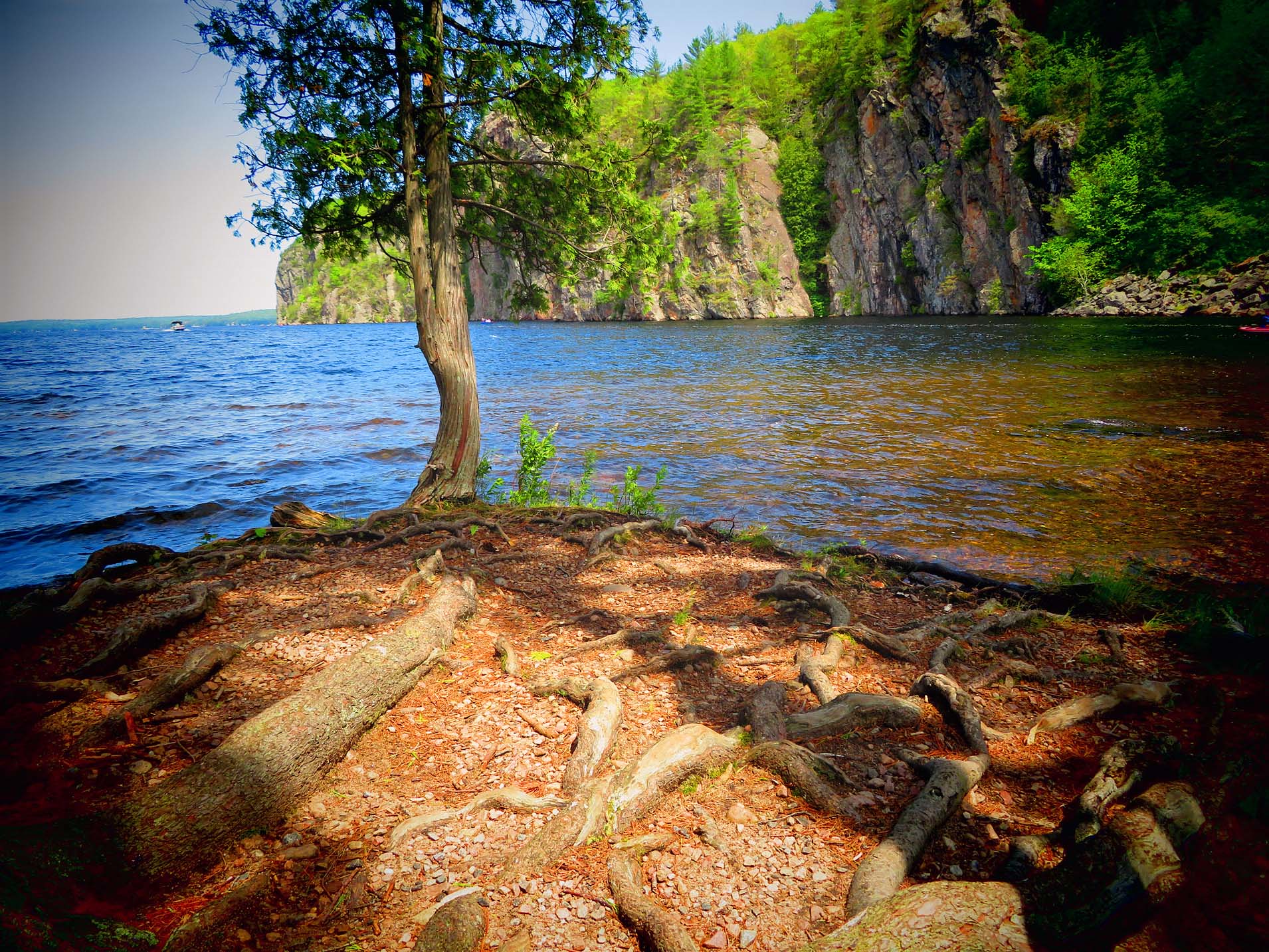 |
| The imposing Mazinaw Rock and Mazinaw Lake |
Except for woodpeckers and barred owls (which I heard and never saw), the only other animal that visited my campsite was a hare, which surprisingly approached me at midnight, while I was still sitting around the campfire. I did not see any raccoons, which in the past were ubiquitous. Because the berries were plentiful, there were no black bear sightings in the park—they did not have to steal tourists’ food.
 |
| Relaxing on campsite #495! The Hermit Thrush nest was under the grill |
I spent a lot of time just relaxing and reading newspapers, magazines and books. I found one of them quite fascinating, “Stalin’s Prosecutor: the Life of Andrei Vyshinsky” by Arkadii Vaksberg. Andrei Vyshinsky (1883-1954) was an academic, diplomat, lawyer, politician (vice-premier from 1939 to 1944 and Foreign Minister from 1949 to 1953), and chief prosecutor—as well as a career criminal against humanity, who used the law to oppress innocent people. He was the chief prosecutor during and architect of the Moscow show trials in the 1930s. Defendants were tortured and intimidated into confessing their guilt; some were promised leniency by Vyshinsky of they confessed, but in any case they ended up shot or sent to gulags. After Stalin’s death in 1953, Vyshinsky was assigned as the Soviet Union’s permanent delegate to the United Nations. He died in New York City in 1954, thus avoiding being prosecuted for his crimes. He was buried in the Red Square and his remains are still interred in the heart of Moscow, in the Kremlin Wall Necropolis, along with Stalin and other Soviet murderers. Well, I cannot and never will understand the masochistic mentality of the Russian people…
 |
| Campsite #495 |
I would like to quote a very interesting passage from this book that probably shows the real Vyshinski:
His outrageousness knew no bounds. Once,
however, he was publicly ‘knocked for six’ with such inimitable style that it
was remembered for a long time afterwards by everyone present.
During a discussion he started making derisive remarks about the Argentine’s permanent UN delegate, Arce, who had tried to dispute Vyshinsky’s editing of a resolution: “Mr. Arce, as far as I am aware, is an obstetrician by profession whereas I am a lawyer and therefore evidently have a better understanding of matters pertaining to international law".
Whereupon Arce replied, "Your informers are mistaken, I used to be a
general practitioner, not an obstetrician, and so I had to do not so much with
bringing people into this world as sending them into the next. So in this
respect, Mr. Minister, you and I are on an equal footing."
This left Vyshinsky literally speechless and he raised no more objections.
The second book I read was “The Racketeer” by John Grisham. A pleasant page-turner, I have to say, with a number of twists, perfect for a camping trip. Yet certainly not Grisham’s top book.
 |
| Guy enjoying the campfire |
Although I did not plan to take the tour boat, I was informed that it was not running this year due to COVID-19. Also, the museum (former home of Merrill Denison, who had donated this property to the Government of Ontario to be turned into a park) was also closed. The adjacent building, run by the Friends of Bon Echo, had some books, souvenirs and clothing for sale, as well a new addition, the Greystones Café. I had a cup of freshly brewed coffee and fudge; both items were much overpriced, but I considered this to be my donation to this dynamic organization. Because of the hot weather and humidity, I was so glad that the showers were open! I think the shower building & equipment in the Hardwood Hill campground have not much changed for the past 30 years, but as long as there was warm water, I was happy.
 |
| This huge chair was here in 1991, when I came to Bon Echo for the first time. There was a small grocery store; now there is a big gas station and a store, coffee shop and sandwich shop |
Several times I drove to Cloyne and Northbrook, as well as to Flinton, where I quickly renewed my car plate stickers, my driver’s license and my health card without waiting—which would be unthinkable in Toronto! I also visited the Flinton waterfalls. There was a small conservational area with a parking for several cars. I was the only visitor. The falls must have been altered significantly long ago, as there were remains of an old dam and powerhouse, built in the early 1900s. I could still see the old turbines and it was possible to walk where the river was once rerouted to power the turbine.
 |
| Flinton-St. John the Evangelist Catholic Church |
While driving on country roads, I frequently stopped and looked for
mushrooms—in no time I managed to find chanterelle, suillus and even bolete
mushrooms! Twice I bought very dry wood from “The Maz”, located in the
intersection of Highway 41 and Snider Road. Years ago there was a restaurant,
auto repair shop and a Petro Canada gas station, run by the Snider brothers. I
remember once seeing all three brothers standing in front of the shop-I should
have taken a photo.
 |
| Ted Snider at Snider's Gulf-Cloyne. Ted Snider - proud owner of Snider's Gulf Station and Restaurant north of Cloyne - business which ran for decades. Snider's was known for their friendly gas and mechanical service and busy family style restaurant. I still remember this place, a restaurant and auto repair shop, run by the Snider brothers. Today it is called "The Maz" and offers kayaks, canoe and paddleboards for rent, as well as sells wood. Copyright © by the Cloyne and District Historical Society (CDHS). Source: https://www.flickr.com/photos/cdhs/ |
I also drove on Head Road to Shabomeka Lake, where I was surprised to see “The Little Free Library”! Coincidentally, I had a bunch of books in my car to donate. There was a public launch ramp and there was a peculiar dock, with a few chairs and other stuff. I was wondering why somebody left this stuff there, but then I saw an attached outboard motor and realized it was a floating dock/raft, quite simple, yet very practical! I briefly spoke to a gentlemen who was about to head to his cottage on this contraption.
 |
| Propelled by the outboard motor, this raft/dock is a simple, yet very practical contraption! |
But now let me turn to the highlight of my trip. Upon arrival at the campsite, I saw a note attached to the post, saying, “Dear Campers, there is a bird’s nest under the grill for the fire pit. Please keep it safe! Carly and Henry.”
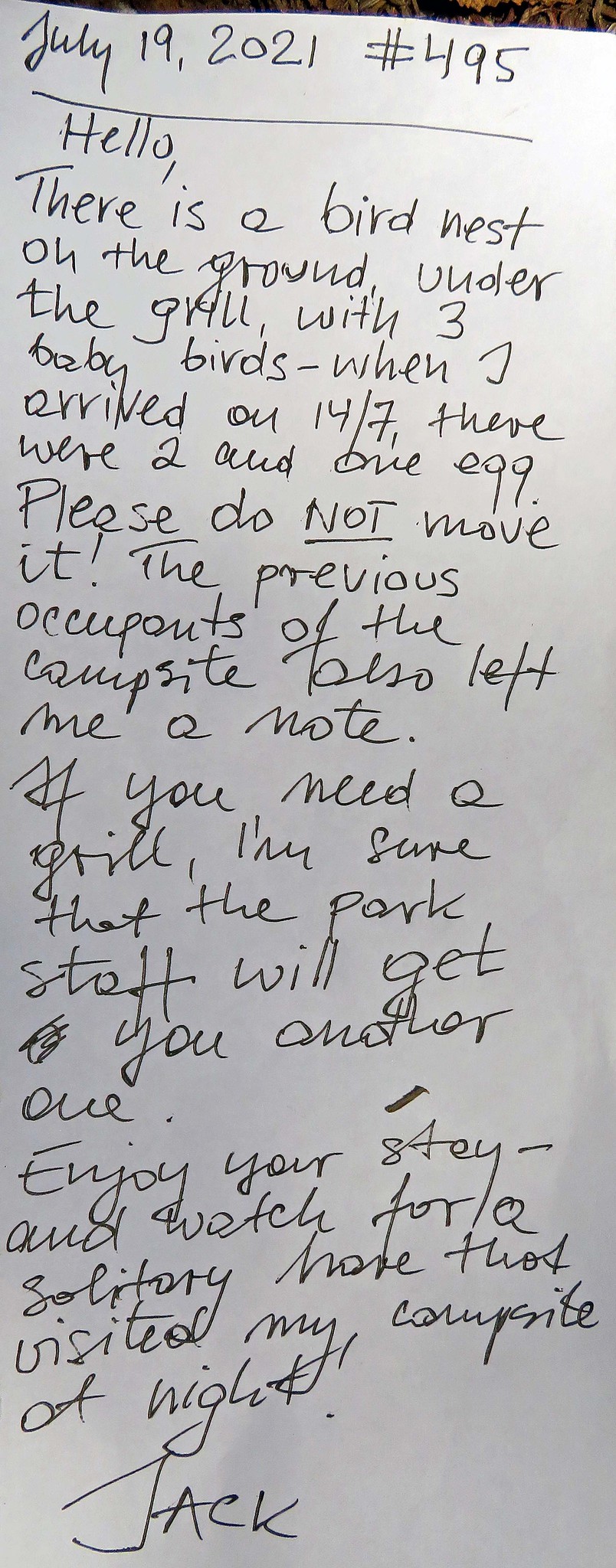 |
| I left this note on the campsite for the subsequent occupants of the campsite |
 |
| Campsite #436, more "open", yet offered less privacy |
I consider Bon Echo to be a very special park for many reasons. In early August, 1991, exactly 30 years ago, Derek P. and I had camped in Bon Echo on nearby campsite #433. Not only was it my first visit in Bon Echo Park, but it was my first camping trip ever to any park in Canada! I will never forget our first night on that campsite—while we were sitting around the fire, enjoying beer and having an animated conversation, raccoons stole most of our food—eggs, butter, buns, hot dogs and sugar!
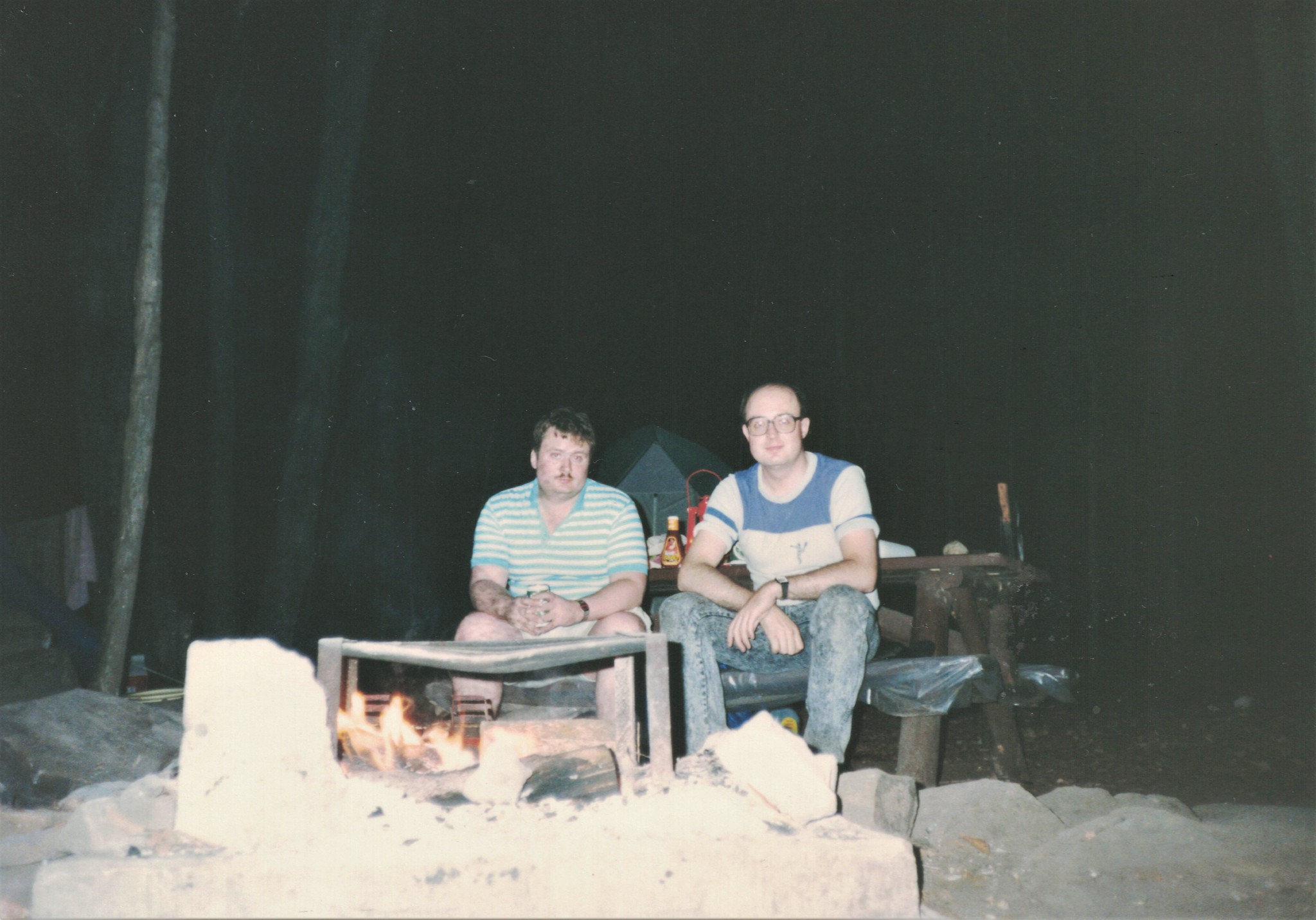 |
| Camping in Bon Echo Park in August, 1991, on campsite #433, with Derek P. My first visit to Bon Echo Provincial Park-and first camping experience in Canada! |
 |
| Campsite #433, where Derek and I camped in 1991, thirty years ago. The trees are gone, but the fire pit still remains |
I found a few photographs from that trip, taken on campsite #433 and then tried to see if I could locate any of the ‘landmarks’, but I think that most trees had been cut down since then. Since 1991 I have visited Bon Echo Park almost 30 times, with close friends, with Meetup groups and with Catherine. I had visited this park three times with Mr. Tadeusz Pasek, a precursor of yoga in Poland—last time we camped in August, 2002, on campsite #488. Mr. Pasek was fascinated with provincial parks in Ontario & Canada, and he especially liked Bon Echo Park. He admired the relaxation, recreation and leisure opportunities such parks offered. While camping, he was making a lot of notes on various aspects of the park and he was planning to later publish them in an academic journal in Poland, but I do not know if he ever managed to do so.
 |
| I spotted this very characteristic tree during my first visit to Bon Echo, in 1991. It has not change much since then! |
Guy stayed at the campsite for several days and brought a big tarp, which came very handy, as it rained several times and it enabled us to more-less enjoy our campsite sitting under the tarp while it was raining. After a few days Guy left for Toronto and Patrizia arrived, of course driving her Tesla!
 |
| The real Tesla-I checked, no exhaust pipe! The first two letters of the registration plate, "GV", stand for "Green Vehicle" (although it's certainly red...) |
She had to be a little more careful about the amount of her driving because there were not any Electric Vehicle charging stations in the vicinity of the park, and all the campsites on our campground (Hardwood Hill) were non-electric.
 |
| I had never managed to make such a tasty cup of coffee as with this Stovetop Espresso Maker! It's small, does not require electricity and can be used during camping trips. |
 |
| The Shield Trail in Bon Echo Park, 5 km long, it takes about 2 hours to do it |
The park has a number of very interesting trails; most of them I had done in the past, but this year was looking forward to re-visiting the Shield Trail (5 km) and do the hike along with Patrizia.
 |
| Hiking on the Sheld Trail |
Ontario Parks published a very informative “Shield Trail Guide,” which greatly enhances the overall hiking experience by supplying plenty of interesting facts on history and natural environment. The trail forms a circular path through the rugged landscape. There are numerous signs along the way, corresponding to the numbered stops in the guide.
 |
| This part of the Shield Trail incorporates the old Addington Colonization Road. Of course, 100+ years ago this road was in a much worse shape, rutted and rugge |
The first part of the trail follows the old Addington Colonization Road, the first road built through the forested wilderness over 160 years ago. The government built a number of such colonization roads to attract immigrants to settle and cultivate the land. Each man over 18 years, who agreed to build a cabin or house within a year, have 5 hectares (12 acres) under cultivation within four years, and help with maintenance of the Addington Road, was given a free 40 hectare (100 acre) lot. Unfortunately, the Canadian Shield was not suitable for farming—even though it could support huge trees (which had all been logged, by the way), it could NOT support crops, especially after the trees were gone and erosion took place. Most farmers eventually failed, but not after toiling fruitlessly on this land for years!
To this time it is possible to suddenly come across a pile of rocks in the middle of a dense forest: over 100 years ago farmers had tried to clear the horrible land by collecting by hands all the stones! There are also remnants of old mining operations along the trail, which unfortunately failed, as the deposits were low-grade ore.
 |
| This photo was taken 29 years ago, in August, 1992, along the Shield Trail |
 |
| Again at the same spot, along the Shied Trail, 27 years ago, in August, 1994 |
There were several glacial erratics—massive boulders brought by huge sheets of ice, which once covered most of North America. One of the erratics had broken into two pieces, probably due to the water that had been seeping for years into its crevices, which froze in the winter, expanded and eventually caused part of the boulder to crack off. In the past I had a picture taken on that erratic and this time took another one, over 29 years later!
 |
| Twenty nine years later, in July, 2021, at the same spot! The boulder has not changed at all; I have... |
My friend Chris Pasek and I had visited Bon Echo in 1992, 1993 and
1994 and each time we had frequently hiked the Shield Trail. In 1991 and 1992
we had often stopped at the beaver pond/wetlands and taken a lot of pictures.
While hiking there in 1993, Chris walked about 15 meters behind me, so I
reached the pond first—and could not believe what I saw!
 |
| This is what we saw in 1993-the beaver pond was gone! |
“The pond is gone”! I shouted.
Chris looked at me, laughed and rolled his eyes, as if saying, “OK Jack, you’re bull***ting me again—you and your stories.” But seconds later he was also in for a big surprise—the beaver pond had literally vanished! It turned out that one day the beaver dam had just burst, all the water escaped and overnight the beaver pond had turned into an empty, muddy basin. We had visited the pond again in 1994 and there had already been a lot of vegetation growing in the depression.
 |
| Beaver Pond in 1994. Vegetation had alredy taken over the muddy bottom of the pond |
So, I was very curious what happened to the beaver pond 27 years later. Well, I was happy to see that a new solid beaver dam was back at the same place and the beaver pond was full of water again! Patrizia and I spent about 30 minutes looking at the photos of the beaver pond taken almost 30 years ago and comparing them the view in front of us. Then we walked along Bon Echo Lake and eventually reached the end of the trail. Walking the 5 km was quite challenging for me, but for most people it should be a rather easy and scenic trail, so if you have an opportunity, certainly do hike there!
 |
| Year 2021: Twenty eight years later the beaver pond is thriving again! |
 |
| Year 2021: 28 years later the beaver pond is thriving again! |
 |
| Bon Echo Park, August, 2007: Nick took this photo of me standing next to a tree with a very characteristic Chicken Mushroom. |
 |
| Nick is taking a "selfie", when this technique was quite unknown |
I am also posting Nick’s photo taken by himself at this tree—very often he took “selfies” when this self-portrait technique, so popular nowadays, was almost unknown. Recently we talked about Nick and agreed that Nick was, at least in our circles, a forerunner of this new method of taking photos.
 |
| Flinton-Catholic Church, St. John the Evangelist |
Patrizia left the Park on Sunday, August 1, 2021, and later that day I drove to Flinton, where I attended a Sunday mass at St. John the Evangelist Catholic Church. Before the mass I walked for a while in the cemetery adjacent to the church. I noticed that one of the more common names was “Lessard”. Flinton, formerly called Flint’s Mills, was established by and named after Billa Flint (1805-1894), businessman and a Liberal member of the Senate of Canada.
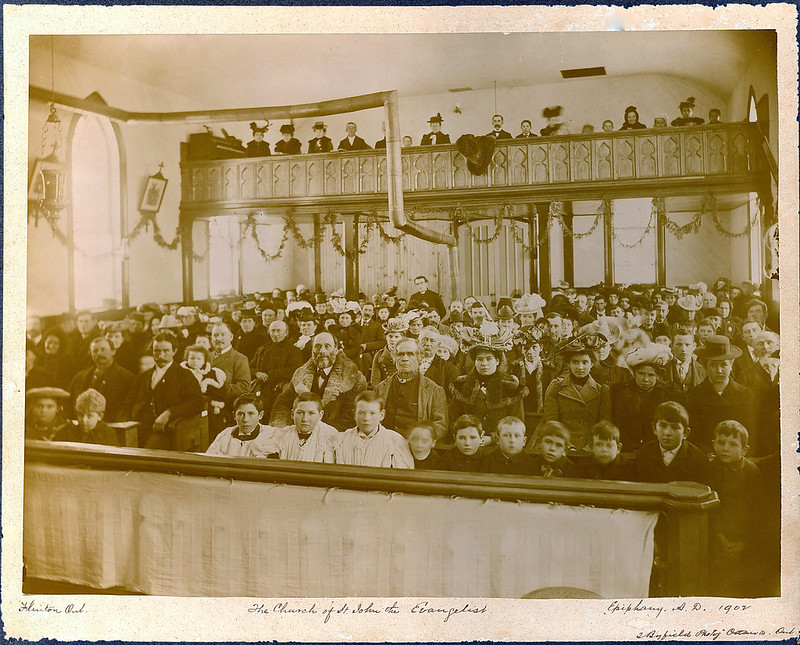 |
| Flinton-St. John the Evangelist Church, 1902. It says, "Epiphany A. D. 1902". So, the photo was taken on January 6, 1902-120 years ago to the day (Januuary 6, 2022)! I am afraid none of these people is still with us here on earth... Copyright © by the Cloyne and District Historical Society (CDHS). Source: https://www.flickr.com/photos/cdhs/ |
The mass was celebrated by a priest originally from Africa. As the Sunday's gospel (Jn 6:24-35) dealt with “bread from heaven,” he talked about the respect for bread in his country and even said a few sentences in his native language. Because of the shortage of priests in Canada, one priest often celebrates many Sunday masses—for example, two on Saturday and three or more on Sunday—all of them in different churches, often far apart from one another. A good and reliable car is a must!
 |
| Guy at Mazinaw Rock |
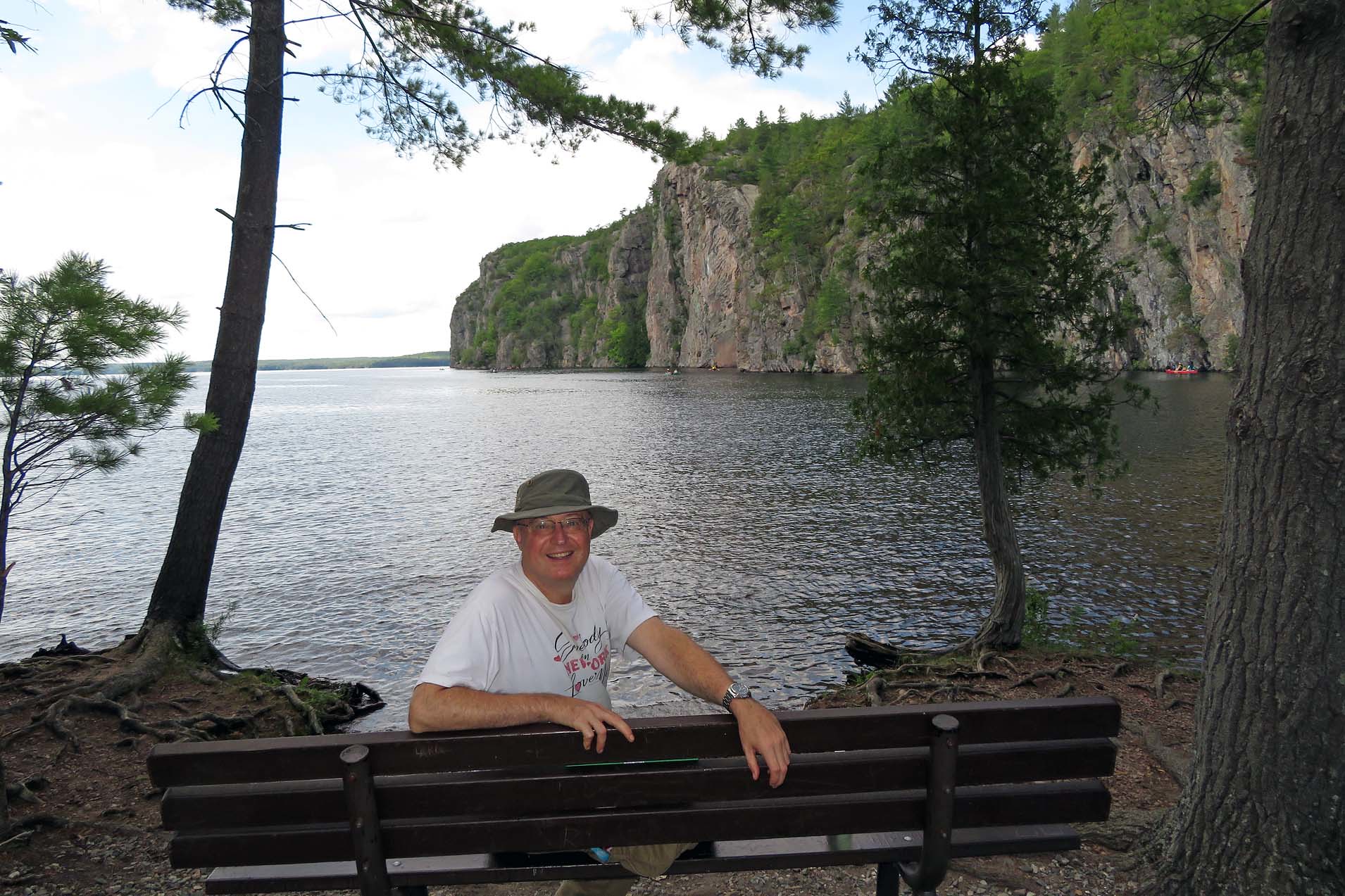 |
| One of the most popular spot to take photos in Bon Echo Park with the impressive Mazinaw Rock in the background |
In September, 2007 a bunch of us from the Toronto Urban Exploration and Adventure Meetup (TUEAM) camped in Bon Echo. There were several group campsites in the park, all of them quite far from other ‘regular’ campsites. We occupied group campsite #7—and since all the other group campsites were vacant, we hanged around the fire until it almost dawned, talking, drinking, singing and enjoying ourselves, without disturbing any other campers. TUEAM, founded and headed by Tammy Hoy, used to be one of the most popular and best-run Meetup groups and organized plenty of amazing, unique and exceptional events (e.g., exploring such landmarks as the abandoned Rochester Subway in Rochester, NY, former Mental Hospital & Military Base near Picton, Ontario and the ruins of the Barber Mills in Georgetown, Ontario). During our stay we drove to and toured Newfoundout, an abandoned Ghost Town in Renfrew County, as well as the abandoned RCAF Station in Foymount (photos: https://www.flickr.com/photos/jack_1962/albums/72157602148116734).
I was curious to see what the group campsites looked like 14 years later. I drove to that area, but was quite surprised that all of them were gone; instead, 12 newly build camp cabins with a rustic wood interior had been erected, which could be rented by those who needed more comfort than ordinary tents could provide!
 |
| The very spot where the group campste number 7 used to be in 2007 |
According to the information supplied by the Park, “the camp cabin is a rustic one room cabin with a rustic wood interior. The cabin sleeps five on a queen bed and double/single bunk bed, features a kitchenette with a microwave oven, mini fridge, kettle and counter space. There is a dining table and chairs, as well as a propane barbeque, picnic table and fire pit outside. In addition, cabins are equipped with electric base board heating”.
 |
| Paddleboards are becoming more and more popular--for both humans and their best friends! |
I guess the park is going to make more money by renting the cabins than group campsites! Nevertheless, I think that group campsites are excellent for larger groups, which do not want to head to bed and be quiet at the 11 pm curfew! I had camped on group campsites in Sandbanks and MacGregor Provincial Parks and still remember such happenings quite well!
 |
| Paddleboards are becoming more and more popular--for both humans and their best friends! |
 |
| Trees die, too... |
As always, packing up and driving home is the saddest part of all of my trips. Normally I get to highway 401 and stay on it until I reach home. This time I was ‘forced’ to avoid the highway, as there were a number of accidents and nothing was moving. Later I found out that those who were at that time on the highway, ended up spending 3 hours in traffic. Personally, I despise being stuck in traffic and I would rather take much slower and often unpaved country/side road than highways which often resemble parking lots.
 |
| The Walker Cemetery, is located literally in the middle of a field |
So, I drove on County 2 Road through Cobourg, Port Hope and then the road turned north—and again west. Just past Kellog Road, on my right, I saw a farmer’s field with a small hill about 30 meters from the road. There was a tree and several old graves (the exact location: N 43 58.200, W 78 21.625 or 43.9700039,-78.3604136).
I made a U-turn, then another one, parked the car on the shoulder and walked to this small cemetery. There were three monuments, with several inscriptions. All had the “Walker” surname. According to my photos, Hugh Walker died in 1807, Mary Johnston (presumably Walker) died in 1850 and Rose Mary Roseborough, the wife of James Walker, died in 1872. According to the “Find Grave” website (https://www.findagrave.com/cemetery/2662856/memorial-search#srp-top), there were altogether 7 records inscribed on the graves. I wished I had had more time to drive to the farm and ask the owner about more information about this very unusual cemetery.
 |
| Rose Mary Roseborough, the wife of James Walker, died in 1872 at the age of 66 |
Last, but not least: the history
of the area, including the Park, is so rich that it requires a separate blog
entry—and a very long one for that matter! I hope that one day I can write much
more detailed history of Bon Echo and the surrounding area.
Blog in Polish/blog
w języku polskim: http://ontario-nature-polish.blogspot.com/2021/12/w-parkach-bon-echo-i-darlington-w.html
More photos/więcej zdjęć: https://www.flickr.com/photos/jack_1962/albums/72177720295612258/page1




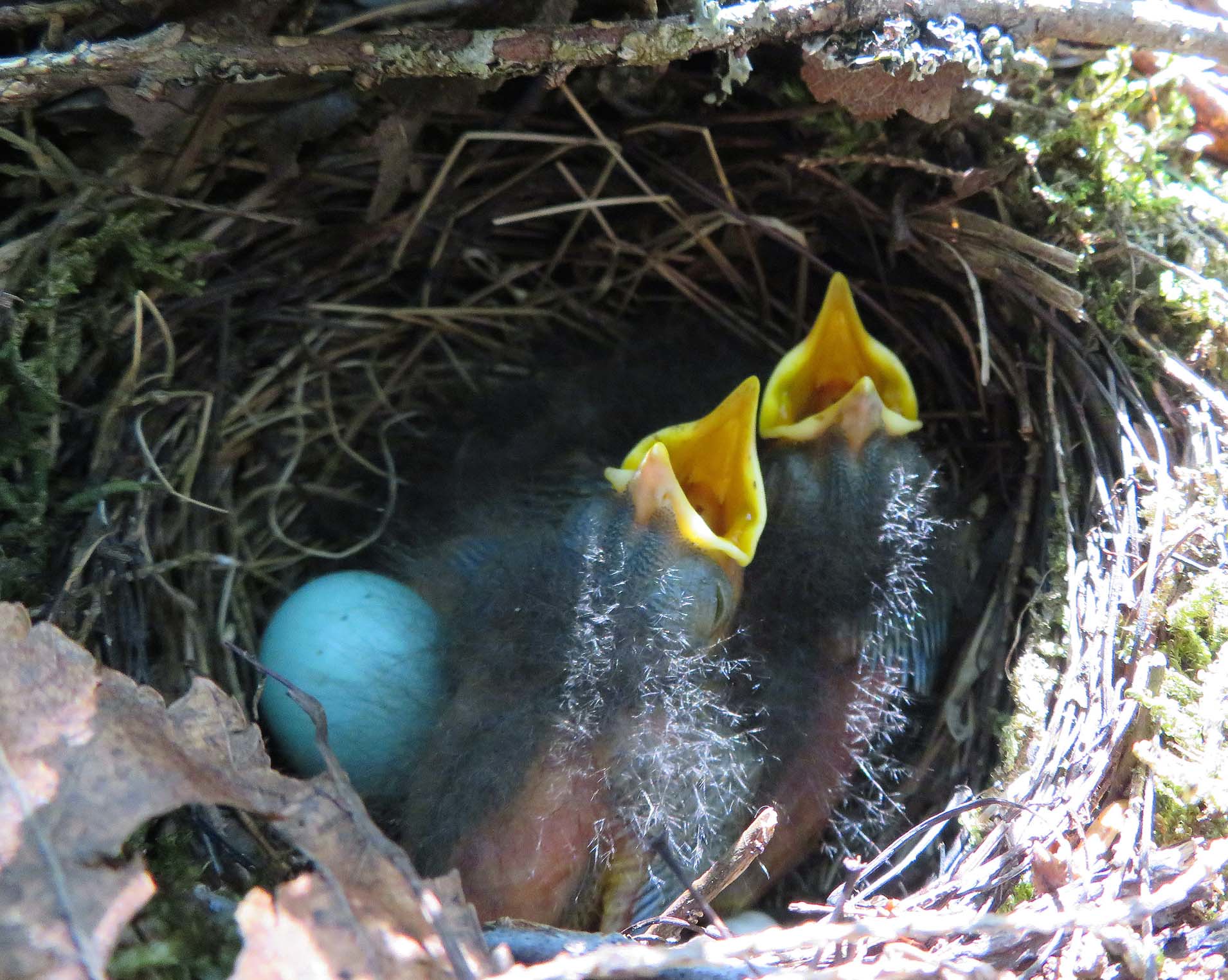

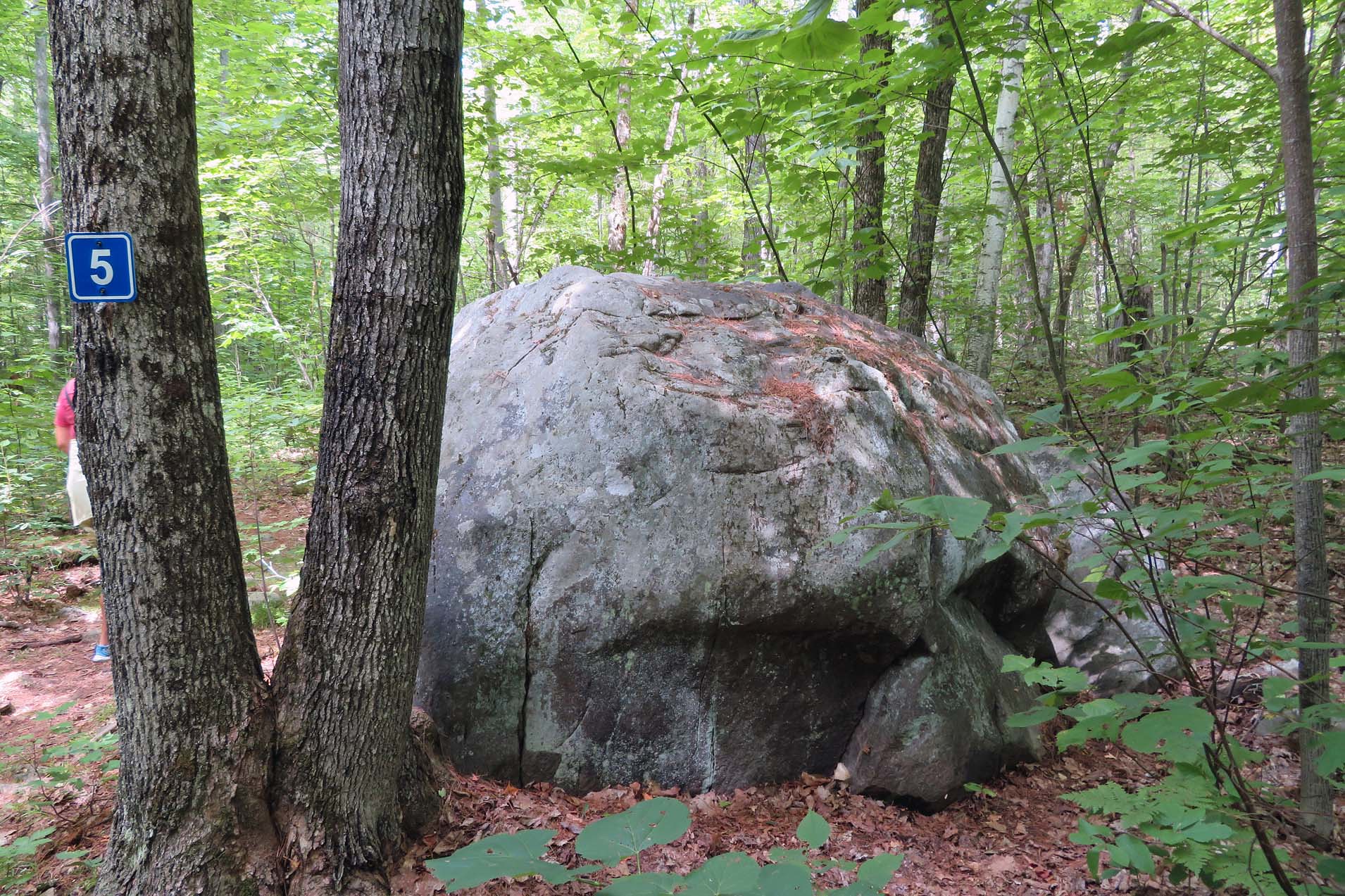



Witaj Jack :) U Ciebie zawsze tyle świetnych ciekawostek i zdjęć że nie wiem od czego zacząć. Znów tyle pięknych miejsc, lasów, jezior. Fajna ta deska z wiosłem i piesem na pokładzie. Pozazdrościć tylko takich przygód i spotkań z przyrodą. Ogromnie jestem ciekawa Kanady może kiedyś uda mi się tam znaleźć. Masz talent do opowiadania i tak miło mi się czyta o twoich podróżach i kempingu. Korków nienawidzę. Dobrze że nie jestem kierowcą. Śliczny ten cmentarz Walker choć przy samej ulicy.
ReplyDeletePozdrawiam serdecznie Ciebie i Cathrine
Kasiu, dziękuję za miły komentarz!
DeletePrzyroda kanadyjska jest rzeczywiście przepiękna i w „zasięgu ręki”. Warto tutaj przyjechać i ją zobaczyć—chociaż sporo turystów głównie ogranicza swoje wizyty do zobaczenia głównych miast i atrakcji. Ja odwrotnie—gdy podróżuję, staram się omijać miasta. Całe życie mieszkałem w dużych miastach i mam ich dosyć. Może jest to jeden z powodów, że nigdy nie ciągnęło mnie do odwiedzenia Polski lub Europy.
Korków też nie lubię, ale one stały się codzienną realnością; szczególnie w okolicach Toronto bardzo często autostrady zamieniają się w parkingi. Na szczęście nie muszę dużo jeździć na co dzień samochodem, jednakże bez tego środka lokomocji byłoby niemożliwością się gdziekolwiek dostać poza główne miasta, szczególnie do parków.
Takich pionierskich cmentarzy jest w Kanadzie sporo. Czasem nagrobki były tak zniszczone, że po prostu je zebrano i postawiono w jednym miejscu. Czasami jednak ich potomkowie nadal mieszkają w pobliskich okolicach i się nimi opiekują.
Nota bene, jestem opóźniony w pisaniu blogów, może wreszcie się wezmę za ich pisanie, a jest o czym!
Serdecznie Ciebie pozdrawiam!